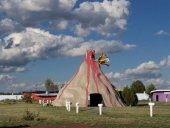SIZE
Smaller is better. The issue here is the ratio of surface area to volume. The higher the ratio, the faster the material will break down. Consider a log as the example. Cut the log in half, you have increased the surface area by exposing the newly split sides, but the volume is unchanged. Keep keep on splitting that log the size of the pieces keep getting smaller but with every split you are exposing more surface area. Wood chips are the same thing as a log that has been split a large number of times. It is on the surfaces that the microbes live and do their thing. More surface area allows more microbes. The microbes generate heat as they do their thing. More surface area will allow a larger population of microbes which in turn generate more heat, but conditions have to be right.
TURNING
The microbes need a diverse diet. The woodchips offer carbon. Grass clippings offer nitrogen. A layer of wood chips on top of a layer of grass clippings has a narrow zone in the middle where the microbes have access to both N and C. I've seen lots of instruction saying to alternate layers in the heap as you build it. This is great advice to help you get the proportions of browns and green right, but these instructions stop short. Take the extra step of tossing the heap immediately. A layered heap will heat up in a few days, and will compost fine. A homogenous heap with a reasonable blend of greens and browns combined with adequate moisture throughout will heat up overnight.
Another key indicator of when to turn is temperature. When the heap begins to cool, it is because the thermophillic microbes have consumed all available food and are beginning to die off. Turning the heap brings unconsumed food to the microbes as well as much needed oxygen and moisture. Turning breaths new life into the heap and will allow higher temperatures to be sustained for a longer period. This will last until the food runs out. It is possible to keep a heap in the thermophillic phase indefinately by adding fresh foodstuffs. I've added bag after bag after bag of lawn clippings to an active hot heap. The clippings are consumed in less than a week. Bear in mind that it is possible to add too much green material. Spontaneous combustion has been documented. I have burned my hand by shoving my arm into a pile.
N LOSS IN MANURE
I've read studies that show the nitrogen loss in cow manure begins immediately. I recall one study that measured soil nitrogen: Plot A had the manure applied and tilled immediately. Plot B had the manure applied and tilled a week later. The N levels in the soil were HALF.
Gather the patties, but get them blended with browns and cover with several inches of material to absorb the ammonia as it volatilizes. Dry leaves are well suited for the task.
Sir Albert Howard covered his Indore Method heaps with a few inches of soil.
PORTIONING
Use weight as the metric. The carbon is not a free molecule, it is contained in cellulose, lignin and organic compounds within the cells. The N is in the form of ammonia and urea within cells. Most plant matter has similar density once it is shredded up, about 5 pounds per gallon. Water can make it seem a lot heavier by filling the spaces between the shredded pieces. As long as the browns are about as moist as the greens, you will be able to estimate equal weights well enough for the process to work. If you can come up with similar weight, all you need is the proportions. I find a pitchfork will let me gauge the weight...as long as my back hurts the same with each forkfull, I'm able to stay consistent.
50 pounds of greens to 100 pounds of browns. This does not have to be perfect. It barely needs to be close. In the ballpark, even way out in left field is good enough. The heap will let you know what it needs. Smelly: add browns. Cool: add greens. Dry: add water
The best way to learn how to compost is to go ahead and pile stuff up. Compost happens even when conditions are not ideal. There is a certain excitement and satisfaction found in building a hot pile, tearing into it and watching the steam rise! Over time, the excitement may cool off right along with the heap, however that satisfaction can develop into pride and accomplishment.
Talking with veteran composters I find a common pattern:
Early composting attempts see great attention to detail, turning the pile religiously, strictly following the directions
Experienced composters turn it less often, keep an eye on the moisture, but generally loosen up the standards and let things slide
Veteran composters pile stuff up and walk away. Nature takes care of the rest.







